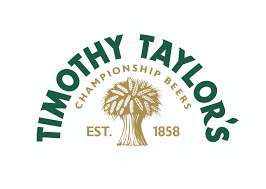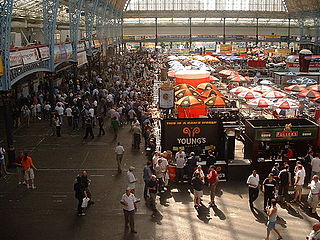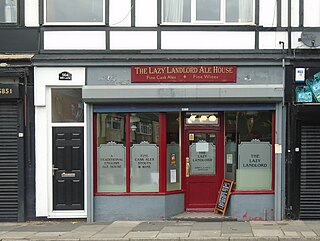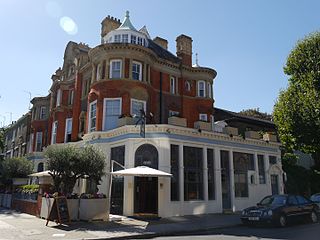
A pub is a drinking establishment licensed to serve alcoholic drinks for consumption on the premises. The term first appeared in the late 17th century, to differentiate private houses from those open to the public as alehouses, taverns and inns. Today, there is no strict definition, but CAMRA states a pub has four characteristics:
- is open to the public without membership or residency
- serves draught beer or cider without requiring food be consumed
- has at least one indoor area not laid out for meals
- allows drinks to be bought at a bar

Beer has been brewed in England for thousands of years. As a beer brewing country, it is known for top fermented cask beer which finishes maturing in the cellar of the pub rather than at the brewery and is served with only natural carbonation.

Timothy Taylor's is a family-owned regional brewery, founded in 1858 by Timothy Taylor, in Keighley, West Yorkshire, England. Timothy Taylor's moved to larger premises in 1863 at Knowle Spring in Keighley, where they remain.

The Great British Beer Festival is an annual beer festival organised by the Campaign for Real Ale (CAMRA). It presents a selection of cask ales, and the Champion Beer of Britain awards, and is held in August of each year. GBBF's sister festival, the Great British Beer Festival Winter, is held in February each year.

Beer in the United Kingdom has a long history, and has quite distinct traditions. Historically the main styles were top-fermented Bitters, Porters, Stouts and Milds, but after World War II lagers took over half the market by volume. The Campaign for Real Ale (CAMRA) was founded in 1971 and has encouraged the preservation and revival of traditional styles of ale. In particular CAMRA has promoted cask conditioned beer, which completes its maturation in casks in the cellar of the pub rather than at the brewery. As of 2014 the UK drank 634 million imperial pints of cask ale, representing 60% of ale in pubs and restaurants and 17% of all beer in pubs. In total 42.42 million hectolitres of beer were produced in 2013 of which 48% was sold in the off-trade.
The National Pub of the Year is an annual competition held by CAMRA, the winner of which is announced in the February of the year following that in which the competition is run, that finds the best pub in the UK. Established in 1988, the competition helps to highlight quality pubs around the UK that are worth seeking out and visiting. Each year, each local CAMRA branch nominates one pub in their area to be entered. These 200 pubs then go through to the regional competition, which then whittles down to 4 pubs to go to the national final.

The Salisbury is a Grade II* listed pub on Grand Parade in Harringay, North London.

The term micropub was originally devised by the Campaign for Real Ale, in the 1976 edition of its Good Beer Guide, simply as a description for an unusually small but otherwise traditional pub. Examples of pubs described as such in this era included Manchester's Circus Tavern and The Nutshell in Bury St Edmunds. In more recent years, the term came to be redefined much more tightly, as a very small, modern, one-room pub, serving no food other than snacks, and "based upon good ale and lively banter". The original of these newly-defined micropubs is often cited as the Butchers Arms in Herne, Kent.

The King's Head is a Grade II listed public house at 84 Upper Tooting Road, Tooting, London SW17 7PB.

The Flask is a Grade II listed public house at 74–76 Highgate West Hill, Highgate, London. According to the 1936 Survey of London, a pub known as The Flask has stood on this spot since "at least as early as 1663". The present buildings probably date from the early 18th century, and were partially rebuilt in about 1767 by William Carpenter. A Manorial court met there in the eighteenth century. The Flask is currently owned and operated by the London-based Fuller's.

The Upper Flask was a tavern near the top of Hampstead hill in the 18th century which sold flasks of water from the spa at Hampstead Wells. It was located in Heath Street. It was the summer meeting place of the great literary and political figures of the Kit-Kat Club such as Walpole. The tavern business ceased in the 1750s and the grand house subsequently became the private residence of ladies and gentlemen such as Lady Charlotte Rich, George Steevens and Thomas Sheppard.

Crocker's Folly is a Grade II* listed public house at 24 Aberdeen Place, St John's Wood, London. It was built in 1898, in a Northern Renaissance style, and was previously called The Crown. Geoff Brandwood and Jane Jephcote's guide to heritage pubs in London describes it as "a truly magnificent pub-cum-hotel" with "superb fittings", including extensive use of marble. The architect was Charles Worley.

The Magdala, also known as The Magdala Tavern or colloquially as simply The Magy, is a pub on South Hill Park in Hampstead, north London. Named after the British victory in the 1868 Battle of Magdala, it was the site of a notorious murder in 1955.

Ye Olde Tavern is a Grade II listed public house at 22 Victoria Rd, Kington, Herefordshire, England, built in the late 18th/early 19th century.

The Red Lion is a disused public house on Soho Road, in the Handsworth district of Birmingham, England.

The Commercial is a public house at 210-212 Railton Road, Herne Hill, London. It is cited in 'The CAMRA Regional Inventory for London' as being one of only 133 pubs in Greater London with a pub interior of special historic interest, most notably for its, "Original counters, bar-back, fireplaces and much fielded wall panelling" dating from the 1930s. In July 2016, Lambeth Council designated The Commercial as a locally-listed heritage asset of architectural or historic interest, being described as a, "Two-storey Neo Georgian style inter-war pub with a three-part convex façade which follows the curve of the building line".

















